A number of the 21 species of ducks found in San Francisco are dabbling ducks - ducks that feed in shallow waters, often with their head underwater and their tails sticking straight up (making it hard to identify them!). February is a great time to look for these ducks - but do it soon - by early March they will be heading north and east to their summer breeding grounds. The lakes in Golden Gate Park - Stow Lake, Lloyd's Lake, North Lake and smaller lakes like Elk Glen Lake - are good places to see many of these ducks.
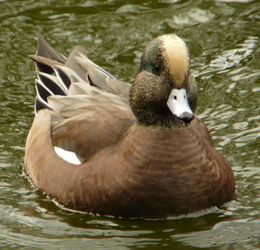 American Wigeon can almost always be found at Lloyd's Lake during the winter. During the summer, it's found mainly in Canada and in the northern interior states. This duck used to be called "Baldpate" for the male's white cap, said to resemble a bald head. This duck is mainly vegetarian, with a short bill that helps it easily feed on underwater plants. If you're lucky, you may also see a Eurasian Wigeon, which looks like an American Wigeon, except that it has a reddish rather than green and gray head. Every year one or two of these strays from eastern Siberia are reported in San Francisco - always in the company of American Wigeon.
American Wigeon can almost always be found at Lloyd's Lake during the winter. During the summer, it's found mainly in Canada and in the northern interior states. This duck used to be called "Baldpate" for the male's white cap, said to resemble a bald head. This duck is mainly vegetarian, with a short bill that helps it easily feed on underwater plants. If you're lucky, you may also see a Eurasian Wigeon, which looks like an American Wigeon, except that it has a reddish rather than green and gray head. Every year one or two of these strays from eastern Siberia are reported in San Francisco - always in the company of American Wigeon.
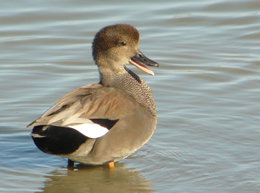 Although not as colorful as many ducks, I personally like the Gadwall, a mostly gray duck with an exquisite pattern of black, white and orange. The origin of this duck's name is not agreed upon, although I like the Webster definition, which says the name is a derivation of gad well, which means "go about well". It's another duck found throughout the northern hemisphere, although not in great numbers anywhere except in India during the winter.
Although not as colorful as many ducks, I personally like the Gadwall, a mostly gray duck with an exquisite pattern of black, white and orange. The origin of this duck's name is not agreed upon, although I like the Webster definition, which says the name is a derivation of gad well, which means "go about well". It's another duck found throughout the northern hemisphere, although not in great numbers anywhere except in India during the winter.
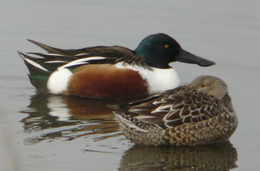 One of our more unusual looking ducks is the Northern Shoveler, with its very large spatula bill. This duck feeds like a baleen whale - it takes in a beakful of water and then strains the water through combs on its tongue to filter out nutritious plankton. It looks front heavy, but is a surprisingly good flyer. The male's bright green head is another distinctive feature.
One of our more unusual looking ducks is the Northern Shoveler, with its very large spatula bill. This duck feeds like a baleen whale - it takes in a beakful of water and then strains the water through combs on its tongue to filter out nutritious plankton. It looks front heavy, but is a surprisingly good flyer. The male's bright green head is another distinctive feature.
Three species of Teal can be found in the Bay Area in the winter, but only one - the Green-Winged Teal - is commonly found in San Francisco. The male of this species has an almost iridescent chestnut head with a green ear patch. It's a small duck, barely more than a foot in length, and the females can weigh as little as 6.5 ounces. They are amazing to watch in flight, since they fly fast, and twist and turn as they fly.
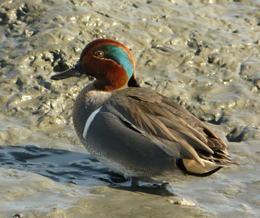
Crissy Field Lagoon can have a number of duck species in winter (mostly diving rather than dabbling ducks). On a walk around the lagoon last week, I was able to see Bufflehead, Greater Scaup, Common Merganser (despite its name, actually a rare bird for San Francisco), Red-Breasted Merganser, Common Goldeneye and Ruddy Ducks.
Some of these ducks are very skittish (Buffleheads almost always dive as soon as you look in their direction), but some are more oblivious to the constant foot traffic around the lagoon. The Common Goldeneye, a handsome black and white bird with a yellow eye, will pose close to the bridge that crosses the east end of the lagoon. The most common duck on the lagoon is often the Ruddy Duck, one of the few ducks found year round in San Francisco. In breeding plumage in the summer, the male Ruddy Duck has a bright blue bill.
 Much less frequently seen in San Francisco (I did see one at Elk Glen Lake in Golden Gate Park earlier this month), is the elegant Northern Pintail, with its long pointed tail. This duck is found throughout the northern hemisphere, is fairly common throughout much of California during the winter, but can also winter almost as far south as the equator. It won't be around here much longer, since this duck will head north to start nesting even before the winter's snow and ice have disappeared completely in its summer breeding grounds.
Much less frequently seen in San Francisco (I did see one at Elk Glen Lake in Golden Gate Park earlier this month), is the elegant Northern Pintail, with its long pointed tail. This duck is found throughout the northern hemisphere, is fairly common throughout much of California during the winter, but can also winter almost as far south as the equator. It won't be around here much longer, since this duck will head north to start nesting even before the winter's snow and ice have disappeared completely in its summer breeding grounds.
And speaking of summer, and migration, the first signs of spring are already here. Last weekend I saw my first spring migrant, an Allen's Hummingbird, posing in the Presidio. This handsome little orange and green hummingbird, less than 4 inches in length, often shows up in San Francisco in late January. It's a bird with a limited summer range - found only on the coast from central California to southern Oregon - and nowhere else.
The other sign of spring last weekend was an active Anna's hummingbird gathering small downy feathers from the bank on North Lake in Golden Gate Park and zipping off with them presumably to build a nest. This resident hummingbird usually builds its small nest with plant down held together with spider web. San Francisco used to be the northern end of the range of this bird, named after the 19th century Italian duchess Anna De Belle Massena. However, urban plantings have allowed this bird to expand its breeding range north to Vancouver and east to Arizona.
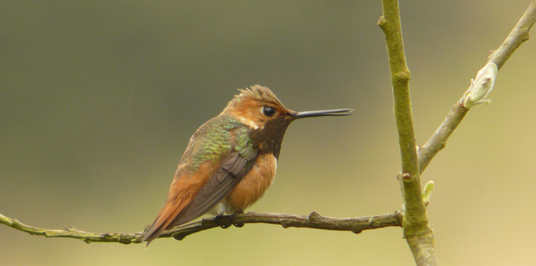
All pictures were taken by David Assmann, Deputy Director of the San Francisco Department of the Environment. Do not reproduce pictures without permission.